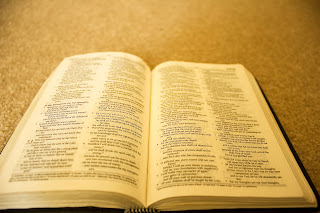NT Reading Schedule
This year's Bible reading plan:
- 1 pass through the Old Testament
- 2 passes through the Wisdom literature (Job, Psalms, Proverbs, Ecclesiastes, Song of Solomon)
- 10 passes through the New Testament gospels
- 20 passes through the New Testament epistles
For the OT it is pretty straightforward: count the number of pages in the OT, count the number of pages in the Wisdom literature, sum and divide by 365 (or some smaller number to give you a buffer)
I wanted to share how I parsed out the New Testament and why.
Each month, I read either Matthew, Mark and Romans-Revelations, or Luke, Acts, John, Romans-Revelations. Not to downplay the Gospels proper as being inferior to the Epistles! The synoptic Gospels obviously repeat common stories with different emphases. Matthew acts as an early catechism. Mark's emphasis is action - εὑθύς - immediately! Luke chronicles quite methodically in his Gospel and Acts, while John, writing later, takes on a more sacramental nature - the λόγος, the Spirit and the Water and the Blood. Splitting the synoptic Gospels every other month allows you to revisit those stories at roughly the same cadence as the epistles. I could see an argument for rotating between Matthew, Mark, Luke every third month and always reading John and Acts... but I'm sticking with it for this year.
It looks something like this:
First Cycle:
- Matthew (4 days)
- Mark (2 days)
Second Cycle:
- Luke (4 days)
- Acts (4 days)
- John (3 days)
All Cycles (each bullet is a day):
- Romans
- 1 Corinthians
- 2 Corinthians
- Galatians, Ephesians
- Philippians, Colossians, 1 and 2 Thessalonians
- 1 and 2 Timothy, Titus, Philemon
- Hebrews
- James, 1 and 2 Peter
- 1, 2 and 3 John, Jude
- The Revelation of Jesus Christ (1-12)
- The Revelation of Jesus Christ (12-22)
Epistles + The Revelation of Jesus Christ takes 11 days, the Gospels takes 6-11 days depending on the month. On average then you can read through the epistles twice, and Gospels once, in just over month. I do these readings first thing in the morning before work and except perhaps for the epistles to the Corinthians they rarely exceed 30 minutes including the OT reading.
The point of this is not to mindlessly tread pages underfoot but to engrain the patterns of Scripture in your mind. I have found, five months into it, that I start to recognize Paul's writing versus John's, for instance. Each pass through I try to have a different idea - repentance, suffering, glory, etc - in mind and watch passages pop out. The epistles were written to churches or individuals as letters to be read in a sitting, and I feel they should be. Now, this is one tool that should be used along with others. This is my "fast cycle", my slow cycle is Will Weedon's "The Word of the Lord Endures Forever," a verse-by-verse Bible study. I also enjoy The Gottesdienst Crowd's Thinking Out Loud series which, weekly, does a deep dive into the one-year lectionary's Gospel reading for the week. The slow pace allows for a deep dive while the fast pace allows for recognition of the patterns and principles of Scripture.
If you haven't sat down and read the Epistle letters as a letter tip-to-tail, I certainly encourage you to give it a try. Even if you gave each epistle a day (double up on the epistles to the Thessalonians, Timothy, and the epistles of Peter and John, given their brevity) it is a very reasonable 18 day cycle.
God bless you in the study of His Word!

Comments
Post a Comment